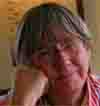Faced with the need to remove some plunger pick ups from the very first ever P4 engine I made a start and the recent mention of CSBs gave me pause for thought.
While there is an intensely complex formula and 'play-with-it' spreadsheet available from the CLAG site I did wonder if ...
1. Is there really such a lot of experience out there in springy-land to confirm the expected results
2. My 28+28 wheel spacing should provide a calculation that is symmetrical about the centre driver
3. My Britannia (ex-DJH) weights 368 grams, or 120grams per axle assuming I can balance it there
4. How does the front pony truck effect the calculation - it seems it should take about 20% of the total weight, what difference will that make to the three driving axles
5. The cross piece of the valve gear supports means that one of the springs (b in the figure on the spreadsheet) can be no longer than 13mm - which rather destroys the symmetry - but this position makes the whole calculation extremely susceptible to error, i.e. 0.5mm error in positioning totally destroys the springing of the centre axle. (10, 13.5. 20, 26)
6. The motor is a Portescap RG4/16M. The need to stop it rotating on its axle will affect the springing on the centre driver, in effect hardening it.
I would like to do this but ...
John
Continuous Springy Beams
-
John Bateson

- Posts: 809
- Joined: Wed Jul 02, 2008 6:39 pm
Continuous Springy Beams
Slaving away still on GCR stuff ...
-
Will L

- Posts: 2530
- Joined: Sun Jul 20, 2008 3:54 pm
Re: Continuous Springy Beams
John Bateson wrote:6. The motor is a Portescap RG4/16M. The need to stop it rotating on its axle will affect the springing on the centre driver, in effect hardening it.
John
Don't think that's necessarily true John but it can be if you don't do it the right way. This is not just a springing thing, torque effects can effect the ride on any chassis in which the motor is mounted on an axle not fixed rigidly in the chassis.
Using a torque reaction link ensures the motor doesn't try and revolve about the axle while transmitting the torque effects direct to the chassis. For those not in the know, this is a wire link between gearbox and chassis. This wire link is arranged to be parallel to the axle centre line. It runs from a point on the motor/gearbox directly above and as far away the driven axle as practical, to a fixed upward extension of the chassis. The link to be free to pivot at both end points. see diagram
Motor/Gearbox Weight
Some people worry about this effecting the springs too. They needn't. The driven wheels does carry the weight of the motor/gearbox, but as unsprung weight so this too doesn't affect weight transmitted through the springs.
That's enough for one post, more to come... possibly.
Will
You do not have the required permissions to view the files attached to this post.
-
Will L

- Posts: 2530
- Joined: Sun Jul 20, 2008 3:54 pm
Re: Continuous Springy Beams
John Bateson wrote:1. Is there really such a lot of experience out there in springy-land to confirm the expected results
Certainly haven't done many yet, but experience to date suggest that the methods is pretty robust and not actually dependent on millimetre precision.
2. My 28+28 wheel spacing should provide a calculation that is symmetrical about the centre driver
Keep it simple, good idea.
3. My Britannia (ex-DJH) weights 368 grams, or 120grams per axle assuming I can balance it there
The spread sheet is written on the assumption you know the weight and where the CofG is and arrange the suspension to suit. This is not a real world position. In many cases, though perhaps not yours, neither the weight nor the CofG of the body are likely to be known until after chassis design. So weighting up the body so the CogG is central over the middle axle, and designing the chassis on that basis is the logical way to go. One of the advantages of CSB's is that the spring rates can be chosen after the event to suit the actual overall weight.
4. How does the front pony truck effect the calculation - it seems it should take about 20% of the total weight, what difference will that make to the three driving axles
Now that is a good question. I have reservations about chassis with lots of carrying axles. For a considered position you will have to wait until I've got my C12 (a 4-4-2 tank) going nicely. For your Brit, you can cheat. Treat it like an 0-6-0 put lots of weight on the bogey and let it go along for the ride (Am I allowed to say that on S4Webforum?)
5. The cross piece of the valve gear supports means that one of the springs (b in the figure on the spreadsheet) can be no longer than 13mm - which rather destroys the symmetry - but this position makes the whole calculation extremely susceptible to error, i.e. 0.5mm error in positioning totally destroys the springing of the centre axle. (10, 13.5. 20, 26)
I appreciate that your dealing with an existing chassis here, but the orthodoxy would be that the cross member concerned needs to be modified to allow the CSB to pass through unobstructed, allowing full freedom to place the fulcrum points where they need to go. Allowing a fixed point on the chassis to dictate a fulcrum point is not a road I would chose to go down
Will
-
John Bateson

- Posts: 809
- Joined: Wed Jul 02, 2008 6:39 pm
Re: Continuous Springy Beams
Torque reaction link...
I have used in the past a pair of 'L' shaped piece of 0.45mm brass attached each side of the (usually) High Level gear box at one end and a cross-wise piece of brass 0.7mm (usually the brake supports) - this seems to work quite well.
Are there advantages to a more rigid structure?
John
I have used in the past a pair of 'L' shaped piece of 0.45mm brass attached each side of the (usually) High Level gear box at one end and a cross-wise piece of brass 0.7mm (usually the brake supports) - this seems to work quite well.
Are there advantages to a more rigid structure?
John
You do not have the required permissions to view the files attached to this post.
Slaving away still on GCR stuff ...
-
Will L

- Posts: 2530
- Joined: Sun Jul 20, 2008 3:54 pm
Re: Continuous Springy Beams
John
As I understand the theory (and I am prepared to be proved wrong!), with an axle with freedom to move up and down and the torque link configured as you have them, the torque reaction will tend to lift up or push down the wheel set, depending on which way the motors turning. This is because the force generate by the motor and that resisting it are not acting in the same plain (at the same angel) as each other and so generate a turning moment around the pivot at the chassie end of the link (i.e. a force trying to lift or depress the axle). Having the link parallel to the axle centre line means the forces act in the same plain and there is no resulting turning force. You'll need somebody who can still explain his school boy physics properly for more authoritative explanation.
The big question is does it matter. Are the forces generated sufficient to make any appreciable difference to how well the chassis actually runs. I think the answer to that is sometimes. On a good free running loco you may never notice the effect, but on one that puts up a lot of internal resistance, you can find odd things starting to happen.
Will
As I understand the theory (and I am prepared to be proved wrong!), with an axle with freedom to move up and down and the torque link configured as you have them, the torque reaction will tend to lift up or push down the wheel set, depending on which way the motors turning. This is because the force generate by the motor and that resisting it are not acting in the same plain (at the same angel) as each other and so generate a turning moment around the pivot at the chassie end of the link (i.e. a force trying to lift or depress the axle). Having the link parallel to the axle centre line means the forces act in the same plain and there is no resulting turning force. You'll need somebody who can still explain his school boy physics properly for more authoritative explanation.
The big question is does it matter. Are the forces generated sufficient to make any appreciable difference to how well the chassis actually runs. I think the answer to that is sometimes. On a good free running loco you may never notice the effect, but on one that puts up a lot of internal resistance, you can find odd things starting to happen.
Will
-
Russ Elliott

- Posts: 930
- Joined: Thu Jun 02, 2011 6:38 pm
Re: Continuous Springy Beams
A couple of points to accompany Will's responses:
Stopping the motor rotating, if it is mounted as described by Will, will not affect the springing on the centre driver. The motor will merely add a little to the unsprung weight of that axle. If you wish to finesse the equitable loading of driven axles, this can be taken into account when establishing the CSB fulcrum points by slackening off the motor axle span by an amount reflecting the later addition of a proportion of the motor weight. In the context of 300 grams tractive, the weight of a proportion of a 1616M won't affect things that much.
Carrying axles need not affect the drivers' CSB plot. Carrying axles and the drivers' CSB (and its fulcrum points) can be considered as separate entities. Weight will be partitioned amongst them according to the normal moments principle, e.g. for a 4-6-0:
Hence the weight over carrying axles can be varied by shifting the CofG. That's easy to say, but, as Will rightly stresses, the overall CofG situation is usually an unknown and changing feast during construction. Ponies and bogies will need a finite force to keep them reliably on the track, and this weight will of course detract from the tractive weight. Symmetrical ponies, as on a 2-6-2 say, are perhaps easier to incorporate, as they will tend to unload the drivers symmetrically, i.e. will keep the CSB 'level'. Bogies carrying an appreciable weight on asymmetrics, as on a 4-6-0 say, will be problematic, because of the need to keep the bogie axle deflections such that they do their job in staying on the track and, secondly, do not 'tilt' the CSB line. This I feel will be as tricky a balancing job as it is on the prototype, and requiring both height adjustability of the bogie frame and a different (softer) deflection characteristic on the bogie.
Stopping the motor rotating, if it is mounted as described by Will, will not affect the springing on the centre driver. The motor will merely add a little to the unsprung weight of that axle. If you wish to finesse the equitable loading of driven axles, this can be taken into account when establishing the CSB fulcrum points by slackening off the motor axle span by an amount reflecting the later addition of a proportion of the motor weight. In the context of 300 grams tractive, the weight of a proportion of a 1616M won't affect things that much.
Carrying axles need not affect the drivers' CSB plot. Carrying axles and the drivers' CSB (and its fulcrum points) can be considered as separate entities. Weight will be partitioned amongst them according to the normal moments principle, e.g. for a 4-6-0:
Hence the weight over carrying axles can be varied by shifting the CofG. That's easy to say, but, as Will rightly stresses, the overall CofG situation is usually an unknown and changing feast during construction. Ponies and bogies will need a finite force to keep them reliably on the track, and this weight will of course detract from the tractive weight. Symmetrical ponies, as on a 2-6-2 say, are perhaps easier to incorporate, as they will tend to unload the drivers symmetrically, i.e. will keep the CSB 'level'. Bogies carrying an appreciable weight on asymmetrics, as on a 4-6-0 say, will be problematic, because of the need to keep the bogie axle deflections such that they do their job in staying on the track and, secondly, do not 'tilt' the CSB line. This I feel will be as tricky a balancing job as it is on the prototype, and requiring both height adjustability of the bogie frame and a different (softer) deflection characteristic on the bogie.
You do not have the required permissions to view the files attached to this post.
Last edited by Anonymous on Tue Oct 13, 2009 8:05 pm, edited 1 time in total.
-
Russ Elliott

- Posts: 930
- Joined: Thu Jun 02, 2011 6:38 pm
Re: Continuous Springy Beams
The absurd edit restriction on posts is really bugging me, Keith. Can we not get rid of it, or at least provide a more leisurely time window?
Last edited by Anonymous on Tue Oct 13, 2009 8:06 pm, edited 1 time in total.
-
grovenor-2685

- Forum Team
- Posts: 3923
- Joined: Sun Jun 29, 2008 8:02 pm
Re: Continuous Springy Beams
Can we not get rid of it, or at least provide a more leisurely time window?
OK, we can give it a try and see if its used sensibly.
Return to “Chassis and Suspensions”
Who is online
Users browsing this forum: ClaudeBot and 4 guests